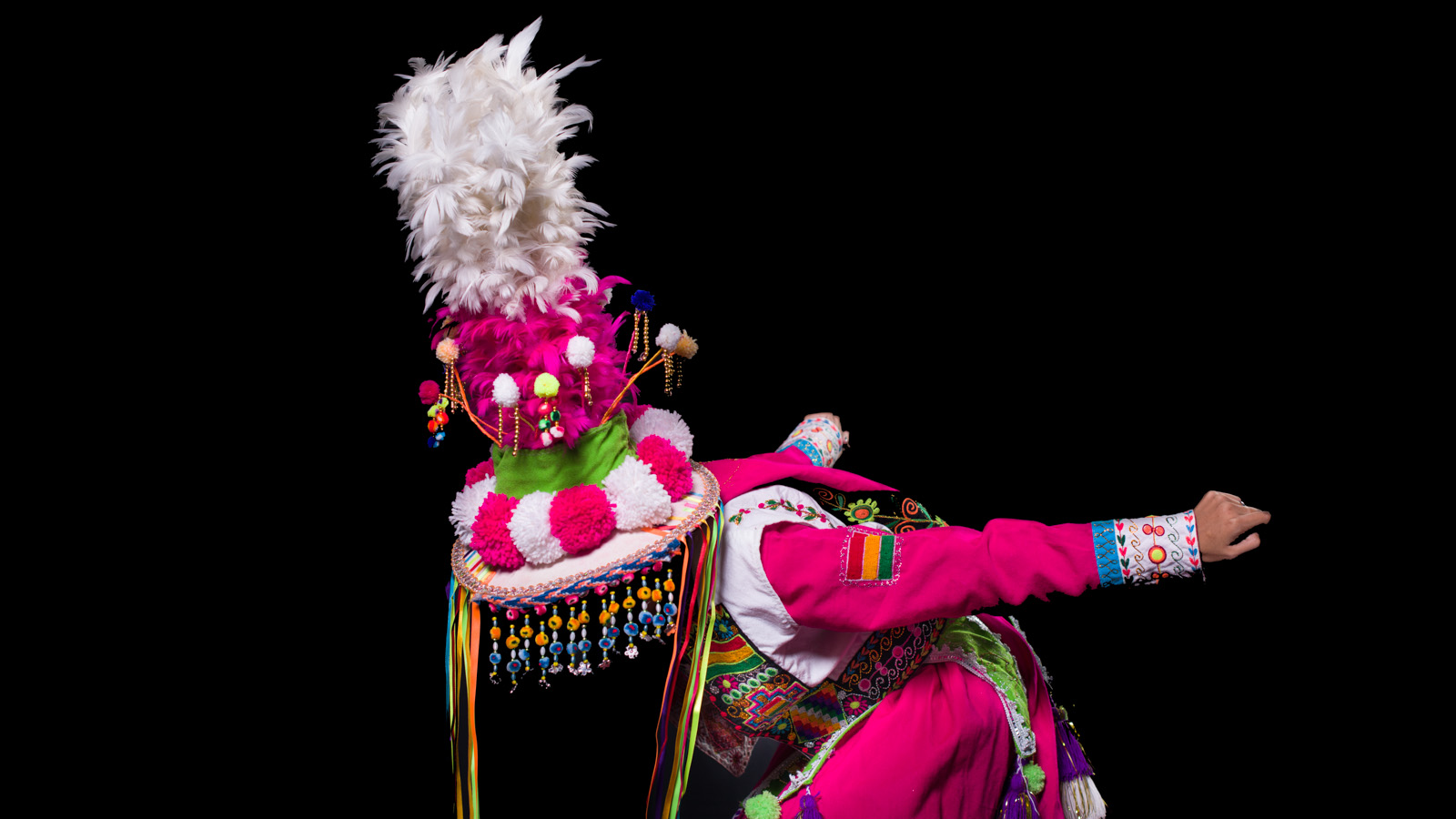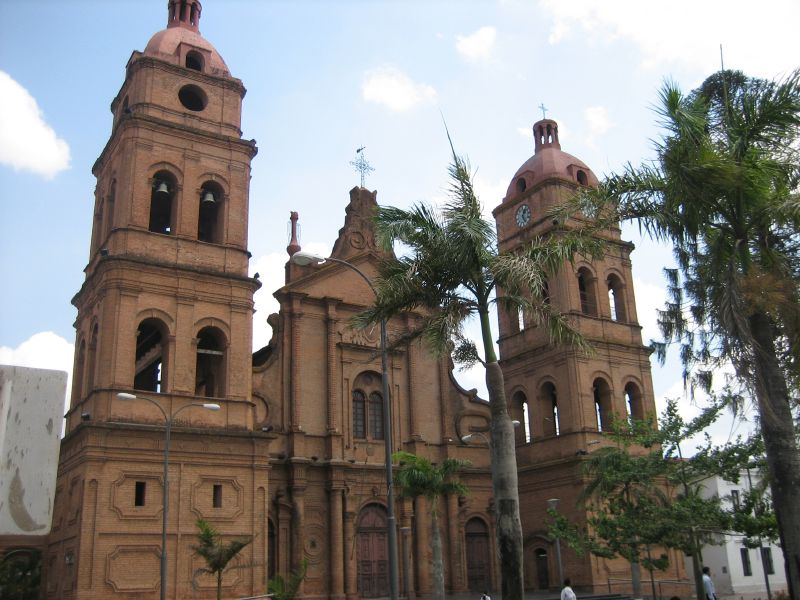|
Tinku
Tinku, a Bolivian Aymara tradition, began as a form of ritualistic combat. In the Quechua language, it means “meeting-encounter". During this ritual, men and women from different communities will meet and begin the festivities by dancing. The women will then form circles and begin chanting while the men proceed to fight each other; eventually the women will join in the fighting as well. Large tinkus are held in Potosí during the first few weeks of May. The story behind this cultural dance is that long ago, the colonial hacendados set fights between indigenous campesinos for their amusement. Pututu trumpets were used by the Indians in order to call for a Tinku encounter, as well as to assemble the peons when the hacendado required of their presence. Tinku dance costumes are colorful and decorative. Women wear a dress, abarcas, and a hat and men wear an undershirt, pants, jacket, sandals (abarcas), and hard helmet like hats. Even though the people were slaves, they loved to d ... [...More Info...] [...Related Items...] OR: [Wikipedia] [Google] [Baidu] |
Tinkus Wistus
The Tinkus Wistus cultural fraternity workshop was founded in 1992 by a group of Bolivian university students concerned to rescue one of the most traditional folk dances of the Andean culture. From the vast range of native dances the group chose the Tinku and added in their name the Aymara Aymara may refer to: Languages and people * Aymaran languages, the second most widespread Andean language ** Aymara language, the main language within that family ** Central Aymara, the other surviving branch of the Aymara(n) family, which today ... word "wistu" meaning "crooked", in allusion to the movements of the dance. Their aim is to preserve the Andean cultural values and to encourage Bolivian youth to know and respect its own culture. The Tinkus Wistus first performed at the Folklore Show of the UMSA (Universidad Mayor de San Andres) in La Paz in 1993; at the 1994 show they won first place, and since then have performed at numerous festivals and displays, representing Bolivia at t ... [...More Info...] [...Related Items...] OR: [Wikipedia] [Google] [Baidu] |
Santiago De Macha
Santiago de Macha or Macha is a Bolivian locality in the department of Potosí, Chayanta Province, Colquechaca Municipality, Macha Canton. Macha had a population of 1,850 in 2001 and the canton was inhabited by 8,769 people. Most of the young adults works abroad, and the marketplace of the village opens only on Sunday. The main economic activity of Macha is subsistence agriculture.''La Nación'' newspaper, 16 June 200(cited on this website) Every 3 May, Santiago de Macha hosts the religious festival of ''Tinku'', an aymará ritual consisting in a fist fighting challenge between two rival groups. Rebel leader Túpac Katari was born in Macha in 1750. Between October and November 1813 the town was the headquarters of the Army of the North The Army of the North ( es, link=no, Ejército del Norte), contemporaneously called Army of Peru, was one of the armies deployed by the United Provinces of the Río de la Plata in the Spanish American wars of independence. Its objective ... [...More Info...] [...Related Items...] OR: [Wikipedia] [Google] [Baidu] |
Bolivian Culture
Bolivia is a country in South America, bordered by Brazil to the north and east, Paraguay and Argentina to the south, Chile to the west, and Peru to the west. The cultural development of what is now Bolivia is divided into three distinct periods: pre-Columbian, colonial, and republican. Important archaeological ruins, gold and silver ornaments, stone monuments, ceramics, and weavings remain from several important pre-Columbian cultures. Major ruins include Tiwanaku, Samaipata, Inkallaqta and Iskanwaya. The country abounds in other sites that are difficult to reach and hardly explored by archaeologists. The Spanish brought their own tradition of religious art which, in the hands of local indigenous and ''mestizo'' builders and artisans, developed into a rich and distinctive style of architecture, literature, and sculpture known as "Mestizo Baroque." The colonial period produced not only the paintings of Perez de Holguin, Flores, Bitti, and others, but also the works of skilled b ... [...More Info...] [...Related Items...] OR: [Wikipedia] [Google] [Baidu] |
Takanakuy
Takanakuy (Quechua for "to hit each other") is an annual established practice of fighting fellow community members held on 25 December, by the inhabitants of Chumbivilcas Province, near Cuzco in Peru. The practice started in Santo Tomás, the capital of Chumbivilcas, and subsequently spread to other villages and cities, the prominent ones being Cuzco and Lima. The festival consists of dancing and of individuals fighting each other to settle old conflicts. Some locals claim to obtain several social benefits from the tradition, while others criticize it. Those in favor claim that public brawling offers an alternative method to resolve conflict and create a peaceful society. Customs Dress There are five types of traditional characters portrayed during the ceremony that have different roles based on Andean cultural symbols. The majority of the dress is based on traditional horse-riding gear and brightly colored Peruvian ski masks, which are characteristic of the specific regiona ... [...More Info...] [...Related Items...] OR: [Wikipedia] [Google] [Baidu] |
Mock Combat
Mock combat involves the execution of combative actions without intent to harm. Participants can engage in such sparring for ritual, training, recreational or performance reasons. The nature of mock combat can vary from realistic to symbolic. Mock combat can be classified into choreographed and unchoreographed forms. Unchoreographed * Display behaviour in tournament species ** Threat display * Ritual battle ** Tinku * Battle reenactment * Military simulation or war games * Sparring Choreographed * Stage combat * Theatrical fencing * Cinematic fencing * Arranged performance fighting * War dance ** Capoeira ** Juego de maní ** Kailao * Kata in Japanese martial arts * Hyung, or poomsae (in Korean martial arts) *Professional Wrestling Professional wrestling is a form of theater that revolves around staged wrestling matches. The mock combat is performed in a ring similar to the kind used in boxing, and the dramatic aspects of pro wrestling may be performed both ... [...More Info...] [...Related Items...] OR: [Wikipedia] [Google] [Baidu] |
Potosí
Potosí, known as Villa Imperial de Potosí in the colonial period, is the capital city and a municipality of the Department of Potosí in Bolivia. It is one of the highest cities in the world at a nominal . For centuries, it was the location of the Spanish colonial silver mint. A considerable amount of the city's colonial architecture has been preserved in the historic center of the city, which - along with the globally important Cerro Rico de Potosí - are part of a designated UNESCO World Heritage Site. Potosí lies at the foot of the ''Cerro de Potosí'' —sometimes referred to as the ''Cerro Rico'' ("rich mountain")— a mountain popularly conceived of as being "made of" silver ore that dominates the city. The Cerro Rico is the reason for Potosí's historical importance since it was the major supply of silver for the Spanish Empire until Guanajuato in Mexico surpassed it in the 18th century. The silver was taken by llama and mule train to the Pacific coast, shipped no ... [...More Info...] [...Related Items...] OR: [Wikipedia] [Google] [Baidu] |
Charango
The charango is a small Andean stringed instrument of the lute family, from the Quechua and Aymara populations in the territory of the Altiplano in post-Colonial times, after European stringed instruments were introduced by the Spanish during colonialization. The instrument is widespread throughout the Andean regions of Bolivia, Peru, Ecuador, northern Chile and northwestern Argentina, where it is a popular musical instrument that exists in many variant forms. About long, the charango was traditionally made with the shell from the back of an armadillo (called ''quirquincho'' or ''mulita'' in South American Spanish), but it can also be made of wood, which some believe to be a better resonator. Wood is more commonly used in modern instruments. Charangos for children may also be made from calabash. Many contemporary charangos are now made with different types of wood. It typically has ten strings in five courses of two strings each, but many other variations exist. The charango ... [...More Info...] [...Related Items...] OR: [Wikipedia] [Google] [Baidu] |
Bolivian Dances
Bolivian may refer to: * Something of, or related to Bolivia ** Bolivian people ** Demographics of Bolivia ** Culture of Bolivia * SS ''Bolivian'', a British-built standard cargo ship A cargo ship or freighter is a merchant ship that carries cargo, goods, and materials from one port to another. Thousands of cargo carriers ply the world's seas and oceans each year, handling the bulk of international trade. Cargo ships are usu ... {{disambig ... [...More Info...] [...Related Items...] OR: [Wikipedia] [Google] [Baidu] |
Religion In Bolivia
Christianity is the largest religion in Bolivia, with Roman Catholicism being the largest denomination. While a vast majority of Bolivians are Catholic Christians, a much smaller portion of the population participates actively. In the decades following the Second Vatican Council (1962–65), the Church tried to make religion a more active force in social life. Statistics A 2018 survey for Latinobarometro returned these results: Other reviews of the population vary from these specific results. Religious freedom The constitution of Bolivia establishes the freedom of religion and a separation between church and state. The constitution further prohibits discrimination along religious lines.International Religious Freedom Report 2017 § Bolivia', US Department of State, Bureau of Democracy, Human Rights, and Labor. Religious organizations are required to register with the Ministry of Foreign Affairs, with the exception of the Catholic Church, whose registration is waived due to ... [...More Info...] [...Related Items...] OR: [Wikipedia] [Google] [Baidu] |
Zampoña
Siku ( qu, antara, ay, siku, also "sicu," "sicus," "zampolla" or Spanish zampoña) is a traditional Andean panpipe. This instrument is the main instrument used in a musical genre known as sikuri. It is traditionally found all across the Andes but is more typically associated with music from the Kollasuyo, or Aymara speaking regions around Lake Titicaca. Historically because of the complicated mountain geography of the region, and due to other factors, in some regions each community would develop its own type of siku, with its own special tuning, shape and size. Additionally each community developed its own style of playing. Today the siku has been standardized to fit in with modern western forms of music and has been transported from its traditional roots. History of the siku The siku ( panpipe) is originally from the Aymaras of Perú and Bolivia, where a woman would play her siku as she came down from the mountains. Since the largest siku has every note (A-G), and was ... [...More Info...] [...Related Items...] OR: [Wikipedia] [Google] [Baidu] |
Conquistador
Conquistadors (, ) or conquistadores (, ; meaning 'conquerors') were the explorer-soldiers of the Spanish and Portuguese Empires of the 15th and 16th centuries. During the Age of Discovery, conquistadors sailed beyond Europe to the Americas, Oceania, Africa, and Asia, colonizing and opening trade routes. They brought much of the Americas under the dominion of Spain and Portugal. After arrival in the West Indies in 1492, the Spanish, usually led by hidalgos from the west and south of Spain, began building an American empire in the Caribbean using islands such as Hispaniola, Cuba, and Puerto Rico as bases. From 1519 to 1521, Hernán Cortés waged a campaign against the Aztec Empire, ruled by Moctezuma II. From the territories of the Aztec Empire, conquistadors expanded Spanish rule to northern Central America and parts of what is now the southern and western United States, and from Mexico sailing the Pacific Ocean to the Philippines. Other conquistadors took over the Inca E ... [...More Info...] [...Related Items...] OR: [Wikipedia] [Google] [Baidu] |





